| T O P I C R E V I E W |
| Jacques M. |
Posted - Nov 19 2014 : 04:42:13 AM
Hello,
I have just bought this camera.
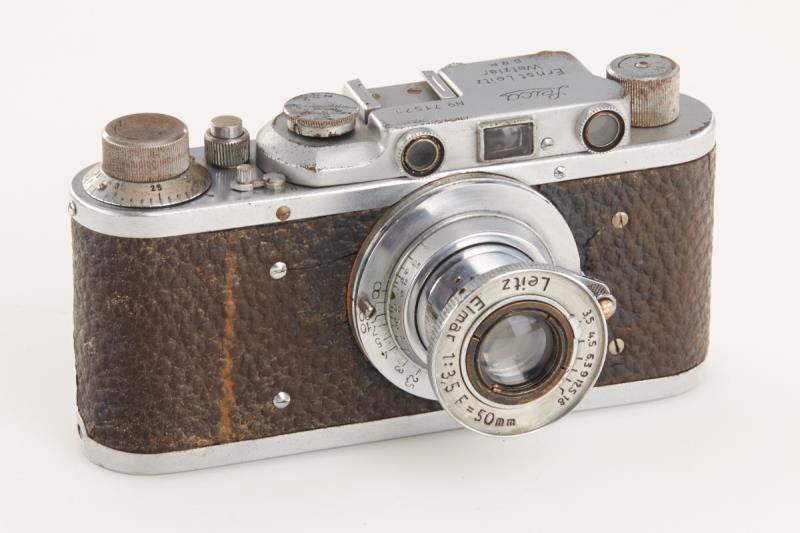
http://www.ussrphoto.com/UserContent/19112014_leica fake 1.jpg
(Leicashop's photo)
Most of the fakes are made from Feds or Zorkis. I am not sure it is the case here...
The screws on the upper plate and on the front of the belt , the metallurgy of the cover, specially about the viewer, the shape and the vertical stripes of the buttons, all is different.
But what if not a Fed? The condition of the chrome means the camera is probably prewar (and that the chrome was not good!). Note that the serial number is at the beginning of the Leica II Couplex series (s/n 71200).
A mix of several parts? But coming from where? A trial? This camera remembers something to me, but what?
Thanks for your opinion!
Jacques. |
| 83 L A T E S T R E P L I E S (Newest First) |
| Luiz Paracampo |
Posted - Jul 24 2018 : 7:40:23 PM
na interesting câmera of course
hand made (due number engravings)
Origins: I feel as French or Italian built
but large possibilities in being
the rare Australian made model 1
or na Argentinian made which no one have ever talked about
Regards
LP |
| Jacques M. |
Posted - Jul 23 2018 : 05:34:59 AM
The seller has modified the description and the URL:
https://www.ebay.fr/itm/Exceptional-and-Unusual-no-name-Leica-standard-copy-WOW/302812653668?ssPageName=STRK%3AMEBIDX%3AIT&_trksid=p2060353.m1438.l2649
Hope that works.
Jacques; |
| Luiz Paracampo |
Posted - Jul 22 2018 : 4:53:58 PM
Oh my dear Jacques!
Tell us which kind of buttons?????
Regards
LP |
| Jacques M. |
Posted - Jul 20 2018 : 4:32:05 PM
Years after, same spring release, same buttons...
Curious!
https://www.ebay.fr/itm/302812405005?ViewItem=&item=302812405005&fromMakeTrack=true
Jacques; |
| Jacques M. |
Posted - Nov 16 2016 : 09:50:13 AM
Thanks, Joseph.
When I bought the camera, the seller (Leicashop)had two other Leica copies, and specially a very interesting Leica fake with the special vulcanite of the NKAP. Unfortunately, I could not get it too.
Jacques. |
| Joseph S |
Posted - Nov 06 2016 : 8:38:29 PM
Old thread, but Jacques's Leica copy seems like a USSR made product to me , maybe not from KMZ or FED but maybe from a shop like the one that made the TSVVS camera. It looks like a camera from a small production run that did not pan out. |
| Jacques M. |
Posted - Jun 22 2015 : 11:14:46 AM
No idea concerning this shutter box made in iron sheet?
I don't remember having seen a Leica like mechanism made of that material. As for the plates and the buttons made in iron too... But I am far for knowing all of them.
Just a guessing. At first sight, it is probably easier to make the mechanism of a prototype in iron sheet whereas the corresponding production will be made of brass or alloy. So, yes, that would leads towards a prototype.
But does this camera, as it is, lead us towards the Neuca? Probably not: they seem too far. This camera would be rather a sort of "orphan" with, perhaps, as ancestry, the mechanism of the Neucaflex... Unless the Neucaflex is derived from this camera??
Amitiés. Jacques. |
| Lenny |
Posted - Jun 17 2015 : 10:26:07 AM
Hi Luiz,
if you have a Ucaflex it must be from 1953 or later, right. Above I posted 2 pictures of Neuca-Prototypes from 1946 and 1948. Both have 6-sided tension setting nuts. Jacques' Neuca has a 4-sided nut for the opening curtain and a 2-sided nut for the closing curtain. I wonder what kind of nuts your Ucaflex has. Maybe you have also 2/4-sided nuts, but just for the opposite curtains. I think the nuts on Jacques' Neuca were changed in postion after the shutter-box was painted some time ago.
Thanks Lenny |
| Jacques M. |
Posted - Jun 17 2015 : 07:30:04 AM
If your Ucaflex has a shutter box made in aluminium, I suppose that the whole series of Uni/Uca/Neucaflex has the same.
I try a magnet everywhere, now!
And in my LTM "Leica like", this camera is the only one to have the shutter box, the buttons and the two plates in iron. The body is in aluminium and the cover in brass with chrome.
Why? I don't really see an explanation for that.
Jacques. |
| Luiz Paracampo |
Posted - Jun 16 2015 : 8:24:20 PM
Not neucaflex excuses.... but UCAFLEX a slight great mistake!
Regards
LP |
| Jacques M. |
Posted - Jun 16 2015 : 03:21:22 AM
Thanks, Luiz.
If you own this Neucaflex, could you make some photos of the shutter box to compare with mine? If possible!
I am surprised by this shutter box and the plates made of iron. A bit unusual... Do you know other examples?
Jacques. |
| Luiz Paracampo |
Posted - Jun 15 2015 : 6:17:43 PM
I actually own this câmera and it is made of aluminium sheets.
I bought it around 1978 with Xenar 2.8 Isogon 40mm and telexenar 180mm and 360mm. na excelente kit!
more interesting I bought a second one identical that I sold soon after I assembled it.
This second câmera was bought by a song in the pouce Market and its prevoius ownwe disasembled completely and put the parts on a bag. Happily there were no parts in abcence. This was twenty years ago.
Regards LP
|
| Jacques M. |
Posted - Jun 15 2015 : 5:08:15 PM
Luiz,
Do you know what the shutter box of the Neucaflex is made of?
On your site, it seems aluminium or iron, not brass: http://www.novacon.com.br/influest12.htm
On my camera, it is made of iron, contrarily to the Neucas we know.
And the base plate is made of iron too. I had not tried a magnet...
So, this camera could derive from a Neucaflex rather than a Neuca?
Thanks. Jacques.
|
| Lenny |
Posted - Jun 15 2015 : 1:01:25 PM
This is the Leica data I know about Jacques:
batch 150201-150850 Leica-3 chrome Dec1934-Jan1935
178255 Leica-3a D.R.P.down
180952 Leica-2 D.R.P.up
batch 183601-183750 Leica-1 Dec1935-Jan1936
There is this black Neuca which might be from 1946
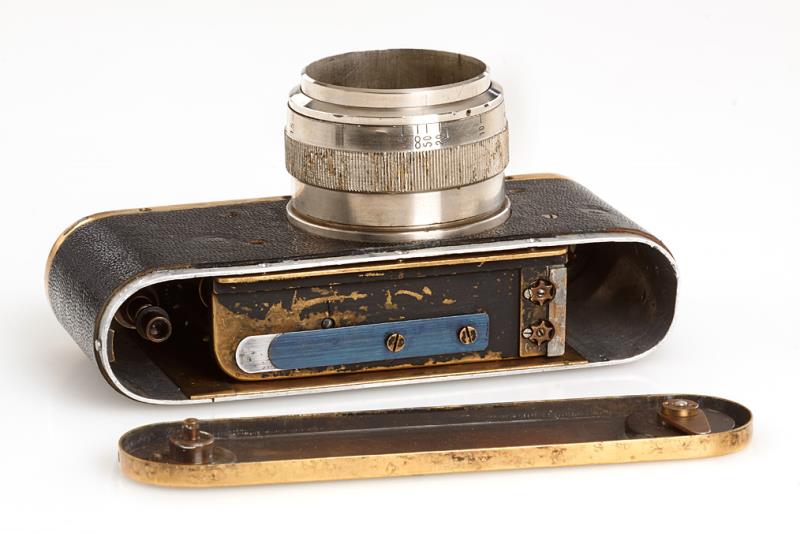
http://www.ussrphoto.com/UserContent/1562015_Neuca-Prototype base2.jpg
Then there is the Neuca which was just sold at westlich, could be from 1948
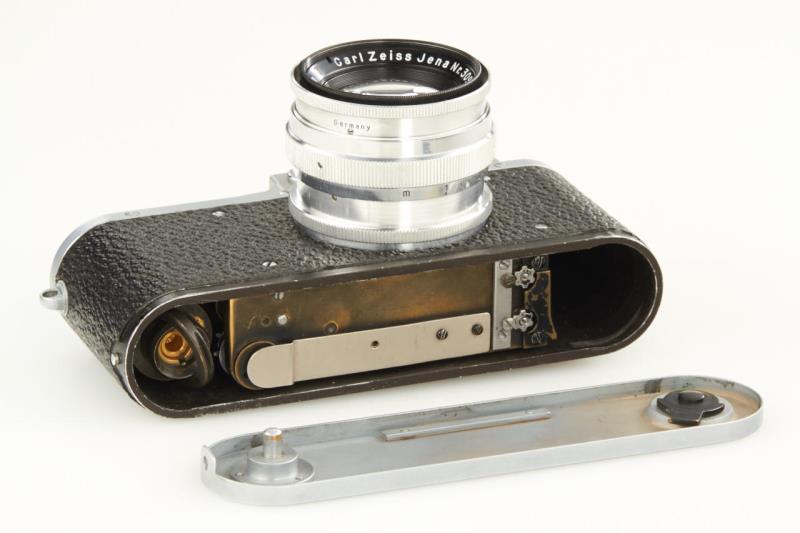
http://www.ussrphoto.com/UserContent/1562015_Neuca proto westlicht 1506251.jpg
They both have six-sided nuts with an additional plate under it and the long shutter-spring. Your Neuca has 2/4-sided nuts without a plate under it and a short spring. I guess your Neuca is a younger evolution. Why start with a shorter spring when Feds had long springs. But still I like your Neuca most, very special.
|
| Jacques M. |
Posted - Jun 15 2015 : 11:14:02 AM
The change of the "DRP" position appeared somewhere in 1935 or 1936. For the moment, I don't have a better estimation. But it is not such important: it was just to enlarge the possible date of making.
And yes, as I have already said, the number is at the beginning of the (D) Couplex series (71200 in february 1932). At that time, all the Leicas were in black, except some special orders.
Having this camera in hands, just a word more. It was strongly used: the peeling of chrome around the speed dial and the two back windows is evident... A prototype which was tested for a possible mass production, perhaps. |
| Lenny |
Posted - Jun 15 2015 : 09:40:10 AM
Hi Jacques,
I think the change of the D.R.P. position was end of 1935. The real Leica #71571 must be an early Leica-II, not an upgraded one, but in black paint. I think because your Neuca looks different, especially under the base-plate, an early serial number was chosen.
By the way, the Neuca which was just sold at westlich for 6600 euro was also sold there in November 2007, lot 332, for 5520 euro, at least the lens has the same number. |
| Jacques M. |
Posted - Jun 15 2015 : 05:35:10 AM
Just a detail more about this camera.
By the position of "D.R.P." (Deutsches Reich Patent) on the cover, the Leica camera which was used as a model was made between 1932 and 1936. After, the "DRP" inscription is in second position, just under "Leica".
That does not really change what we had said. But the camera could have been made before WW2 too.
Amitiés. Jacques. |
| Lenny |
Posted - Dec 14 2014 : 4:40:56 PM
quote:
Originally posted by Jacques M.
I don't want to modify anything on this camera. The curtains are just partially jammed, and it would be easy to restore them. But I prefer to keep it in its actual condition.
I can understand that and of course this Neuca is very very special, but isn't it tempting to see how this gem works.
When I get an old camera, first I check if the shutter works. Sometimes the gears are dry and instead to clean and lube it the previous owner only increased the tension to keep it working. I lower the tension then first to give the camera some rest and sometimes I keep it cocked for some days to give the opening curtain some rest too. I'm sure these old cameras are in good hands when we have them. |
| Jacques M. |
Posted - Dec 14 2014 : 09:01:51 AM
To Lenny: I don't want to modify anything on this camera. The curtains are just partially jammed, and it would be easy to restore them. But I prefer to keep it in its actual condition.
To Stephan: good question! The lens flange is standard (28,8/28,9mm by my caliper).
Amitiés. Jacques. |
| Lenny |
Posted - Dec 07 2014 : 08:45:33 AM
bonjour Jacques,
you have this Neuca gem for nearly 2 weeks now. Could you clean it and make it work again? How does it sound?
Did you change the tension setting screws? The 4-sided nut is on the closing curtain which is not necessary because it doesn't need so much tension as the opening curtain. The 4-sided nut would be much better on the opening curtain to adjust it better. I think they were changed by mistake. Too bad there is no inside photo of the Neuca from 1948 for comparisons. Interesting is that the black Neuca from 1946 has two 6-sided nuts like on Leicas and then Neuca went away from that and changed to 2-sided and 4-sided nuts. |
| stephanvdz |
Posted - Nov 28 2014 : 6:45:43 PM
as for the screw on the top right... winder end: both my redcurtains IIIc have a screw on that end of the top, but not on the other side...
that's what you were remembering at the beginning of the discussion. But it's the only thing that this camera has with a stepped IIIc.
nice find... may be you should fit the odd 50mm F2 partially coated lens on it... ;-)
by the way is the lens flange at the (almost) standard register ?
Stephan |
| Jacques M. |
Posted - Nov 28 2014 : 03:13:58 AM
Sorry, Lenny, I cannot be precise: the two cameras are remounted now.
If you look at the photo I posted at 09:18:04, you see the housing of VF/RF (in brass). The right and (particularly?) left spaces are less important on the Neuca.
Another photo to compare the covers with their different shapes. It's all that which allows to place the button, I think.
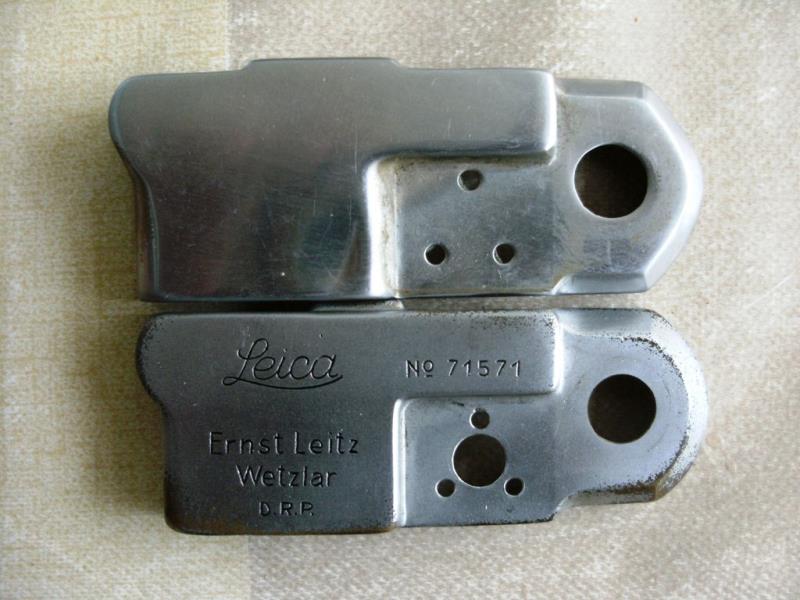
http://www.ussrphoto.com/UserContent/28112014_DSCF1733.JPG
Amitiés. Jacques.
|
| Luiz Paracampo |
Posted - Nov 27 2014 : 4:43:35 PM
No, Lenny Unfortunatedly Not.
As I could see, This neuca prototype, is better careful made than Uca.
Flensburg The sucessor of Neuca.
LP |
| Lenny |
Posted - Nov 27 2014 : 3:57:14 PM
Hello Luiz,
on your website you have 2 more photos of the silver Neuca from 1948 which was sold in the Westlicht auction in 2007. Did you own it before? Does it have the same technic under the baseplate as Jacques Neuca? Because the black Neuca from 1946 is more simple there. |
| Lenny |
Posted - Nov 27 2014 : 3:56:16 PM
quote:
Originally posted by Jacques M.
The distance between the finders (3,8cm, axle to axle)is the same. It's just the house of the VF/RF which is a bit less large on the Neuca (4,8cm vs 5,1cm).
Is it 3mm less on the rewind side or did they move the whole top more to the middle to gain more space for the bigger rewind knob?
Thanks again Jacques for all these photos. |
| Jacques M. |
Posted - Nov 27 2014 : 09:29:34 AM
A last detail: the rewind lever, with its arrow shape and its curious screw.
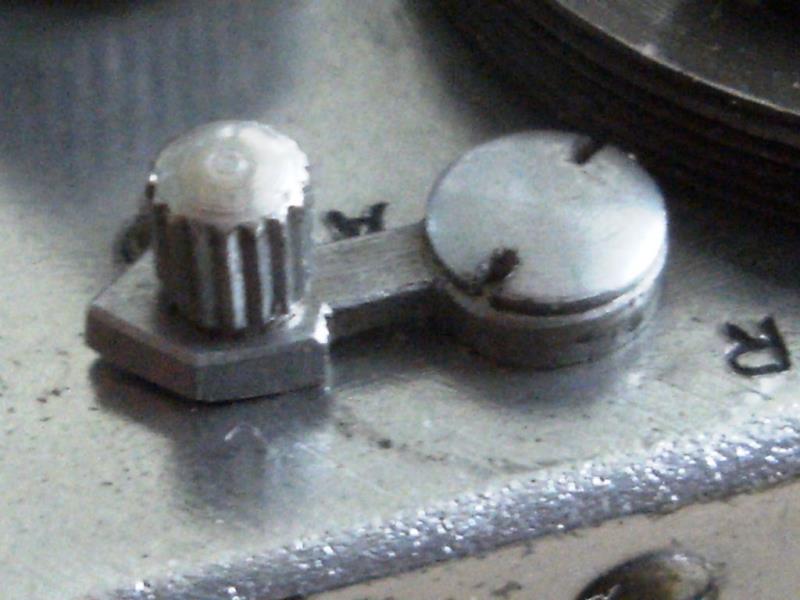
http://www.ussrphoto.com/UserContent/27112014_DSCF1747.JPG
When opening the cover, I hoped an inscription or something... There was nothing, in fact!
Don't hesitate if you have questions...
Many thanks for your help!
Jacques.
|
| Jacques M. |
Posted - Nov 27 2014 : 09:23:53 AM
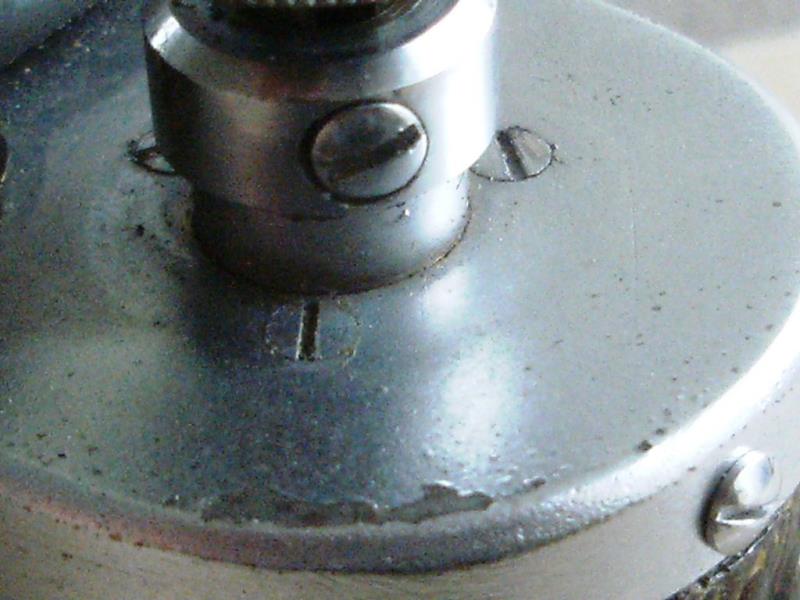
http://www.ussrphoto.com/UserContent/27112014_DSCF1744.JPG
The three screws under the rewind button. The summit of the triangle is towards the left (towards the right on the early Feds and Leicas).
|
| Jacques M. |
Posted - Nov 27 2014 : 09:21:10 AM
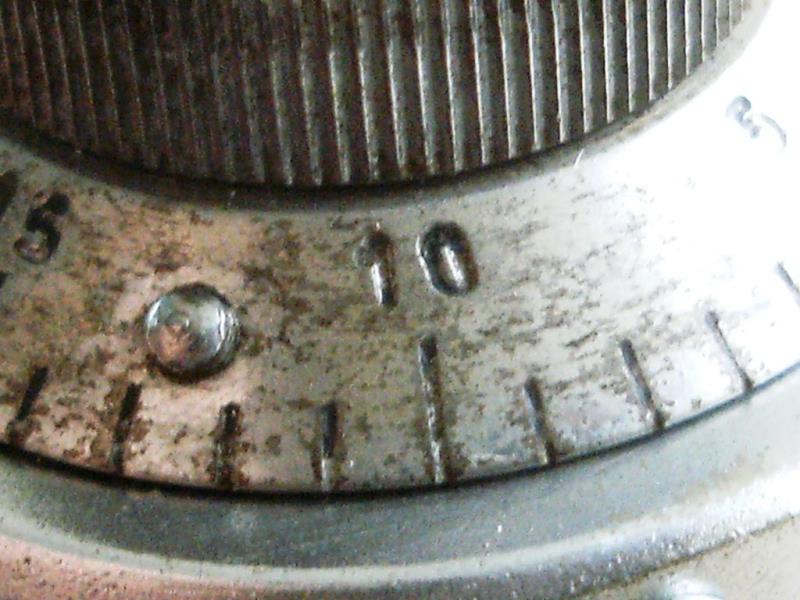
http://www.ussrphoto.com/UserContent/27112014_DSCF1731.JPG
The engraving on the winding button, smaller than Fed's.
|
| Jacques M. |
Posted - Nov 27 2014 : 09:18:04 AM
Thanks, Luiz. A pity that few of these cameras were made. In fact, each camera is almost a prototype...
Some last photos with cover removed.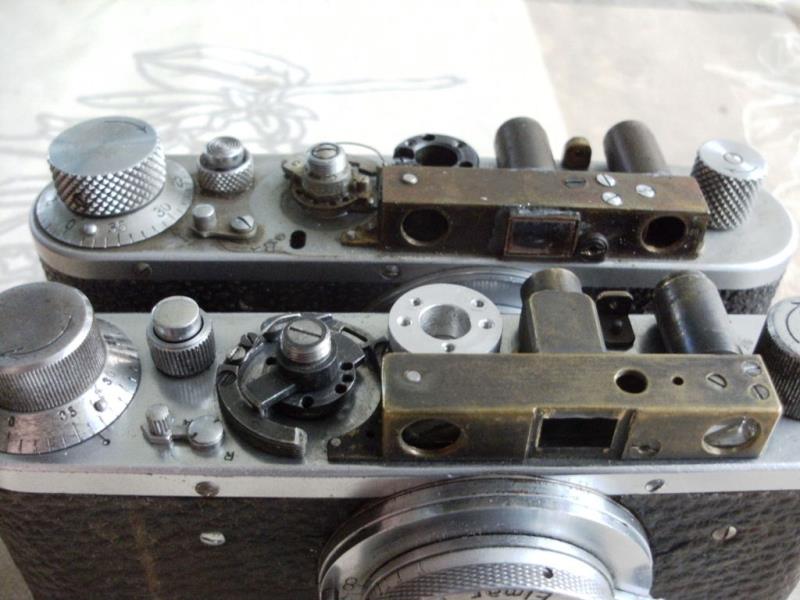
http://www.ussrphoto.com/UserContent/27112014_DSCF1742.JPG
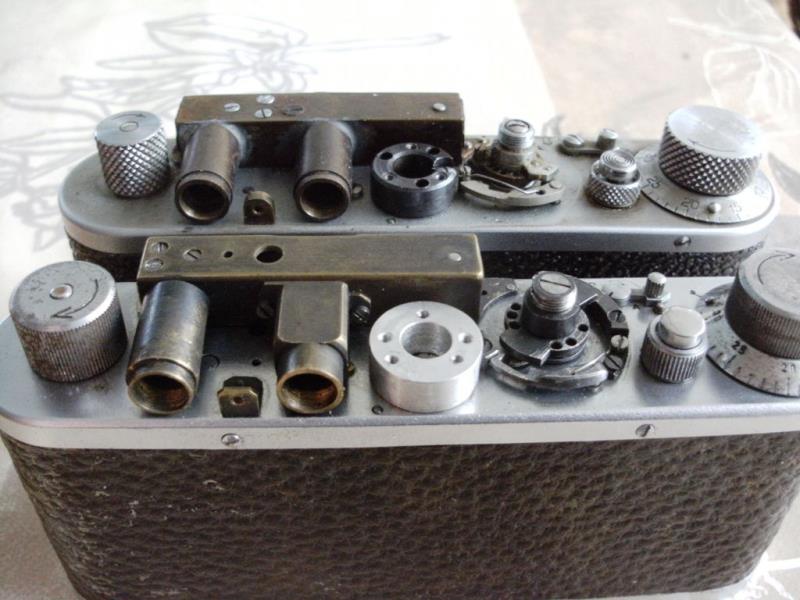
http://www.ussrphoto.com/UserContent/27112014_DSCF1743.JPG
On both photos, the Leica/Neuca is on the foreground.
Always many small differences...
The distance between the finders (3,8cm, axle to axle)is the same. It's just the house of the VF/RF which is a bit less large on the Neuca (4,8cm vs 5,1cm).
|
| Luiz Paracampo |
Posted - Nov 26 2014 : 5:16:53 PM
The Neucaflex prototype
at http://www.camerasdownunder.com/gallery/displayimage.php?pid=52&fullsize=1
see also at http://www.ebay.de/itm/Franz-Robert-Neubert-Neucaflex-Prototype-/251067428307
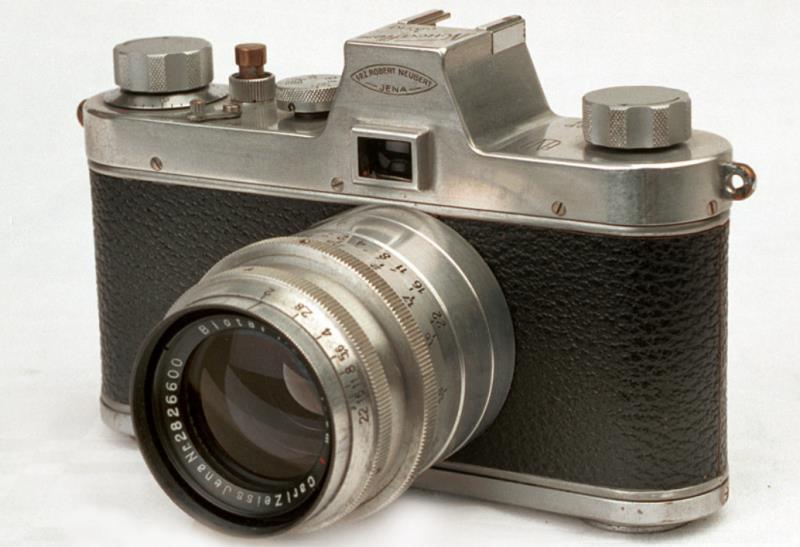
http://www.ussrphoto.com/UserContent/26112014_neucaflex.png
|
| Lenny |
Posted - Nov 26 2014 : 1:09:23 PM
quote:
Originally posted by Jacques M.
If somebody has details about Neuca production, of course, I would be interested.
I was surprised to see a Neuca rangefinder-cam with serial #1019 on novacon.com. Now I wonder if this is cam #19 or if they produced more than thousand of this model. That must have been in East-Germany at that time where Leica's patent rights were not valid. Somewhere else I read that only 100 were produced, so who knows. Not easy to get this info and even Leicashop couldn't recognize this Neuca, even they sold one in 2007 which must have the same technic under the baseplate.
How lucky Jacques is and good that this Neuca is in good hands.
Now that everyone knows how close this Neuca is to a Fed (it really seems that Fed is the mother) this cam is worth much more.
|
| Luiz Paracampo |
Posted - Nov 26 2014 : 12:21:15 PM
Now Leica re introduces na all mechanical film câmera with no exposure meter
http://leicaphilia.com/leica-introduces-an-all-new-film-camera-the-leica-m-a/
Go to Top of Page
|
| Luiz Paracampo |
Posted - Nov 26 2014 : 12:19:57 PM
Now Leica re introduces na all mechanical film câmera with no exposure meter
http://leicaphilia.com/leica-introduces-an-all-new-film-camera-the-leica-m-a/ |
| Luiz Paracampo |
Posted - Nov 26 2014 : 12:14:44 PM
Hello all
around 1975 I bought for a song a complete set of Udaflex with Xenar 2.8/50 a Xenagon 4.5/40, and two Tele-Xenars 100 and 200mm
All im perfect using conditions.
Around 2000 it appeared a second câmera of the same second series (reversed Exakta bayonet lock) which the owner had completely dismantled ant put its parts on a bag.
Some parts desappeared.
New Gears were taken from Zenit E and the firing button was taken from a fountain pen! Identical to the original one!
I observed that screws were the same of Zenit which are the same from Zorki and FEDs.
To me there ar several "Lost Loops" among FEDs and Neucas
Mainly due the era in which they were produced 1946/1947.
As I know Neuca were prohibited to be produced due Leits Patent infringements
Regards |
| Jacques M. |
Posted - Nov 26 2014 : 11:28:59 AM
As for the weight: 391g vs 415g for the Fed 1 to which the camera was compared (with their spools).
Both are remounted. I could see that the screws are shorter on this "Neuca-Leica": two turns and it's tight...
If somebody has details about Neuca production, of course, I would be interested. Here is the link to Luiz's site towards the Uniflex/Neucaflex:
http://www.novacon.com.br/influest12.htm
The Neucaflex's shutter box is the same as on this camera.
Jacques. |
| Lenny |
Posted - Nov 26 2014 : 06:42:18 AM
quote:
Originally posted by Jacques M.
In fact, all is the same and all is different... And delighted to get this camera. And delighted to get this camera.
Thank you so much Jacques for posting all these pictures so I could see this wonderful Neuca technic. Too bad they didn't produce more of them. I'm sure you are very very happy.
Seems this prototype had a blank top either so it was destined to get faked by an uninformed fool.
|
| Jacques M. |
Posted - Nov 26 2014 : 05:45:07 AM
I feel that Luiz is certainly right. So, this camera could be a Neuca prototype... When I see the back of the shutter box of the Ucaflex (on Luiz's site), all seem the same: the screws, the shape of the box, the absence of rims to strengthen all that...
Two other details:
- the bottom screw, under the lens, which tightens the shutter box, is absent. But it screws from the outside contrarily to the Leicas' and early Feds' on which it screws from the inside.
- the three screws under the rewind button are present, like on early Feds. But 2 screws (out of 3) are towards the outside (1 on Leicas and Feds).
In fact, all is the sams and all is different... And delighted to get this camera. And delighted to get this camera.
Many thanks to you, Luiz and Lenny.
I post other photos if I can.
Amitiés. Jacques. |
| Lenny |
Posted - Nov 25 2014 : 6:38:50 PM
Seems Luiz is right.
This Neuca-Prototype from 1946 seems to be similar. This cam was in the Westlicht auction #23, lot 379, sold for 6800 euro (there are more pictures on leicashop.com).
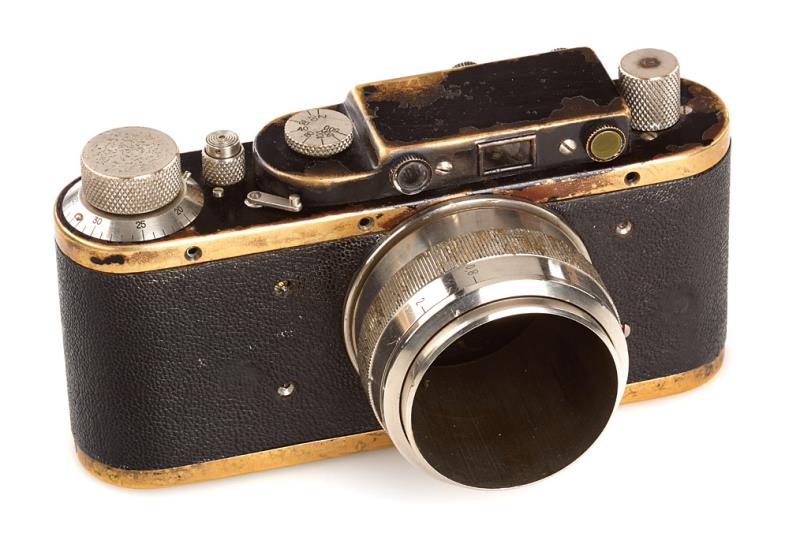
http://www.ussrphoto.com/UserContent/25112014_Neuca_Proto_1946.jpg
Then there was another Neuca-Prototype from 1948. This cam was in the Westlicht auction #12, lot 332.
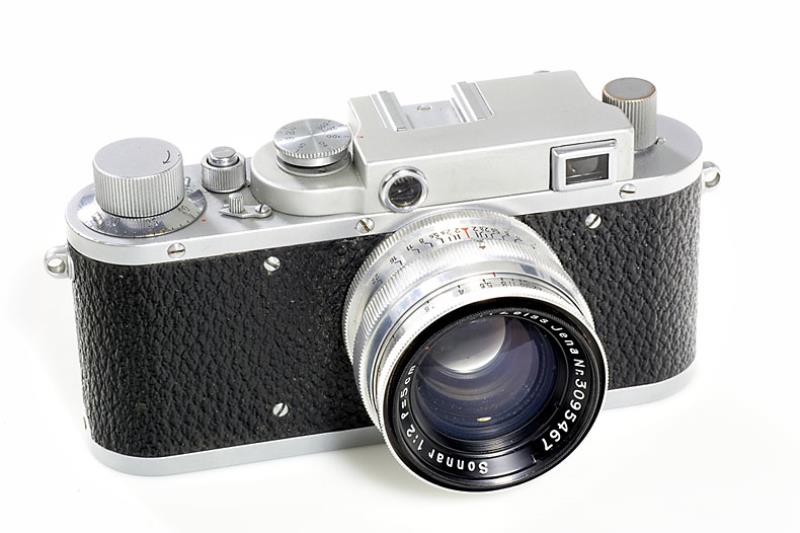
http://www.ussrphoto.com/UserContent/25112014_Neuca_Proto_1948.jpg
Could be Jacques cam is between both cams pictured above. What a find!!! |
| Luiz Paracampo |
Posted - Nov 25 2014 : 5:37:22 PM
The lock and short spring reminds the Ucaflex, a direct descendant of the Neuca.
I immediatly did note the top rangefinder case as smaller than FEDs,
so the distance betwwen oculars.
The sensor rangefinder pin the bottom lock and perhaps the oculars shape (smaller) are typically from Neuca . that took different shapes along its small production.
Original lenses came from ROW, Zeiss Jena or Schneider, or what they find.
Much strange are the different shutter lock nuts?
Regards
LP |
| cedricfan |
Posted - Nov 25 2014 : 1:52:02 PM
quote:
Originally posted by Lenny
Leicashop handles Leica copies on a dayly basis, like on their auction last weekend. The fact that they assume it's russian made could be because they might not be so familiar with russian cams.
And by the lens, as it is so obvious fake from a Russian lens 
Best regards,
Juhani |
| Lenny |
Posted - Nov 25 2014 : 12:02:15 PM
Leicashop handles Leica copies on a dayly basis, like on their auction last weekend. The fact that they assume it's russian made could be because they might not be so familiar with russian cams.
Good that the shutter box has only 4 screw-holes on the frontside (there is another hole below the lens-mount). This 4 visible screws on the frontside should help to find the origin. But if it was a prototype we might never know. Still fantastic to own this cam and I assume it wasn't so expensive, worth every Cent for sure. |
| Jacques M. |
Posted - Nov 25 2014 : 11:15:03 AM
To Lenny:
- the metal ring behind the lensplate is completed by a paper shim (5 on the Fed 1d showed!).
- both baseplates have the same dimensions.
- I think that the lens was home adapted. But the body certainly was made for a M39 lens.
- you are right, there is 1/2mm less between VF/RF on the backside.
To Juhani:
This camera is odd. And it was used (traces of film on the cage), so it worked. Certainly it was made by a factory: I cannot think that a workshop would be able of that...
Thanks for your comments!
Jacques. |
| cedricfan |
Posted - Nov 25 2014 : 10:20:54 AM
"a" and "Z" are German: Auf and Zu. So as this is most likely not a fake but a completely odd camera, this may be one clue?
Best regards,
Juhani |
| Lenny |
Posted - Nov 25 2014 : 05:53:01 AM
quote:
Originally posted by Jacques M.
The adaptation of the lens was certainly home made. But not the mechanism.
Jacques, do you mean the M39-mount was added home made? |
| Lenny |
Posted - Nov 25 2014 : 05:47:17 AM
quote:
Originally posted by Jacques M.
Compared to a Fed's, the cover of the fake seems shorter on the right (when looking from the front).
It seems the distance between RF-eye and VF-eye on the backside is shorter. |
| Lenny |
Posted - Nov 25 2014 : 05:37:40 AM
quote:
Originally posted by Jacques M.
The two baseplates (with z and a on the Leica fake).
Jacques, have both baseplates the same length? |
| Lenny |
Posted - Nov 25 2014 : 05:32:05 AM
quote:
Originally posted by Jacques M.
And the lensplate. On the Leica fake (forehand), the shim is realised with a ring of metal. Strong paper on Feds.
This metal distance ring seems to be a step back. With the paper shims the mount can be adusted much better and sometimes were used in more layers on one side then the other. |
| Jacques M. |
Posted - Nov 25 2014 : 05:28:55 AM
Just a last one about the cover.
Compared to a Fed's, the cover of the fake seems shorter on the right (when looking from the front).
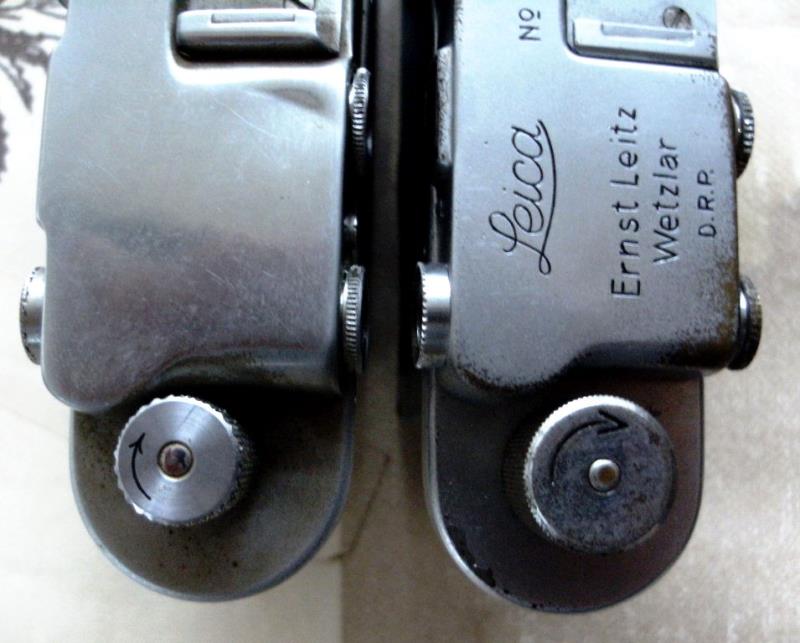
http://www.ussrphoto.com/UserContent/25112014_DSCF1707.JPG
The Fed is in fact a "no name", as you can see.
That's all for today. If I can, I will post some other photos of the ciphers and of the inside of the rangefinder.
The adaptation of the lens was certainly home made. But not the mechanism. So, where does it come from?
Amitiés. Jacques.
|
| Lenny |
Posted - Nov 25 2014 : 05:21:30 AM
quote:
Originally posted by Jacques M.
Detail concerning the screws to regulate the shutters and the lock of the baseplate.
Note that the Leica used two slot screws for their shutters until 1931, then 4 slots in 1932 (appearance of the Leica II), then 6 slots (Leica III). Fed kept the 2 slot one, except on the only Fed b (or V) I have seen (4 slots).
The lock of the baseplate is original.
Thank you so much Jacques. I love it. You must be very happy to own this cam. This cam seems to be much more advanced in technic.
I love that there are 2 different locking nuts of tension setting screws, A 2-sided nut is only needed for the closing curtain because it doesn't need much tension. A 4-sided nut is much better for the opening curtain which needs much more tension and so it's better to adjust. But here it's just opposite, the opening curtain has the 2-sided nut only. Seems someone changed it by mistake. |
| Jacques M. |
Posted - Nov 25 2014 : 05:11:13 AM
The two baseplates (with z and a on the Leica fake).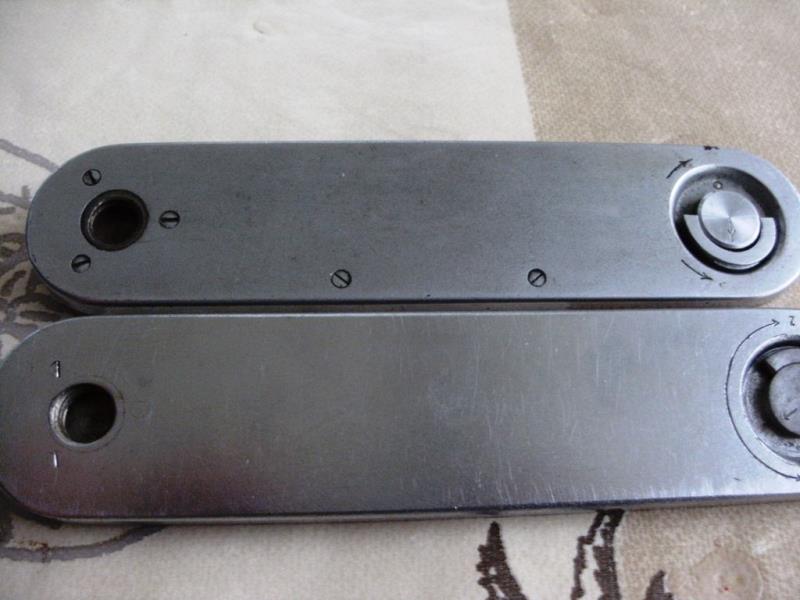
http://www.ussrphoto.com/UserContent/25112014_DSCF1710.JPG

http://www.ussrphoto.com/UserContent/25112014_
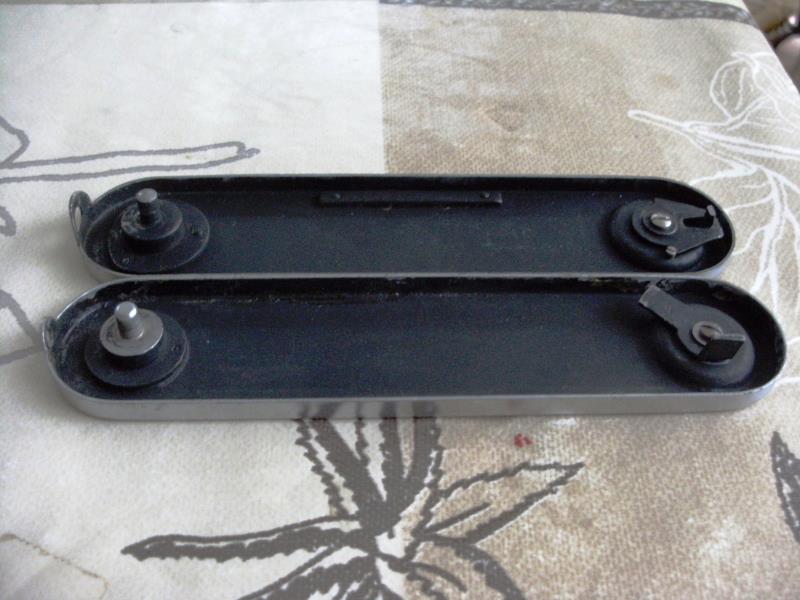
http://www.ussrphoto.com/UserContent/25112014_DSCF1712.JPG
|
| Jacques M. |
Posted - Nov 25 2014 : 05:06:33 AM
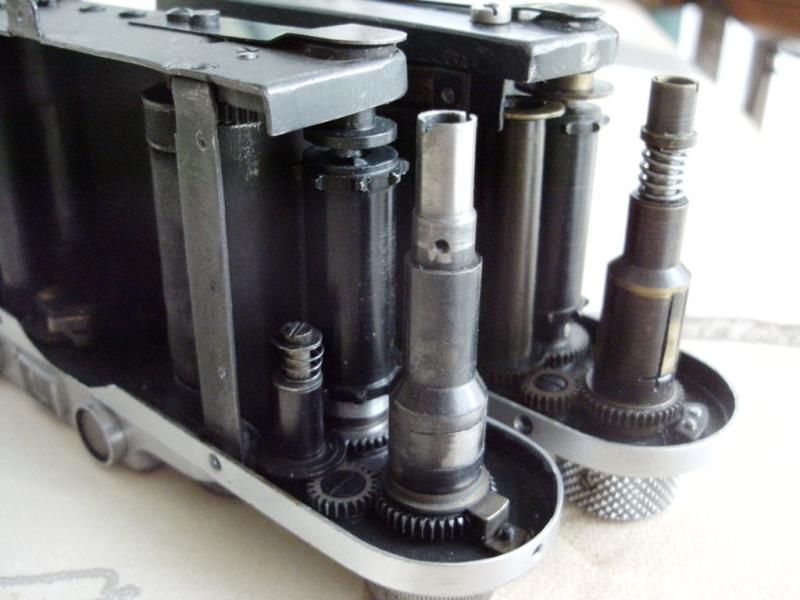
http://www.ussrphoto.com/UserContent/25112014_DSCF1700.JPG
The principle of the winding lever is the same, but the realisation is quite different. Idem for the winding button.
|
| Jacques M. |
Posted - Nov 25 2014 : 04:58:25 AM
The part of the body which receives the lens, lens plate dismounted.
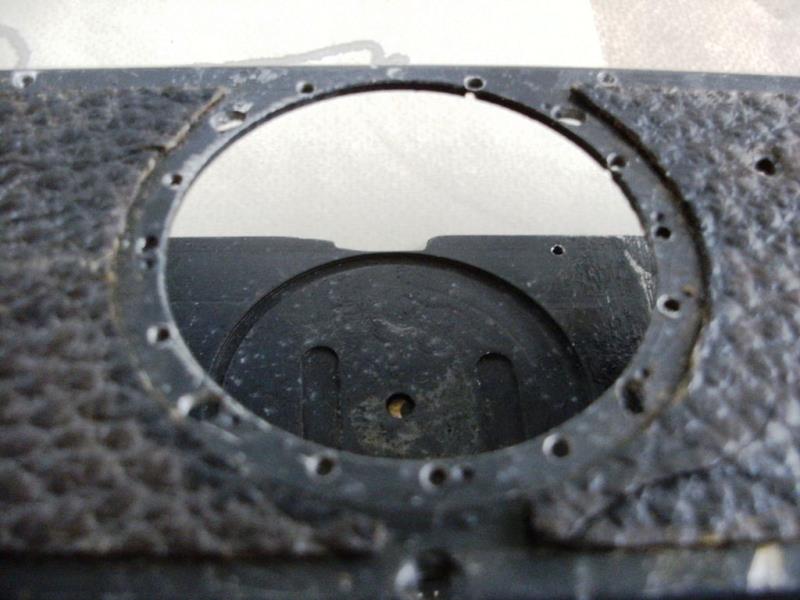
http://www.ussrphoto.com/UserContent/25112014_DSCF1709.JPG
Many holes. Only four are enlarged to receive the corresponding screws.
And the lensplate. On the Leica fake (forehand), the shim is realised with a ring of metal. Strong paper on Feds.
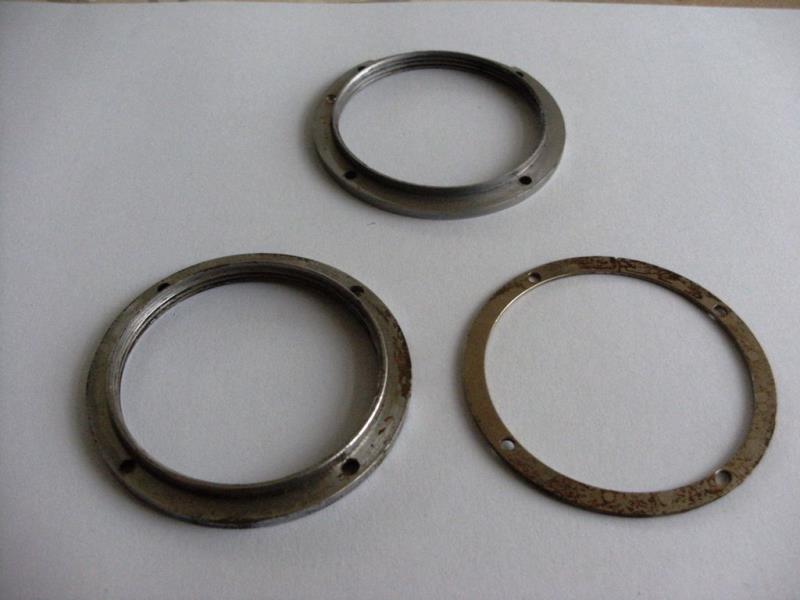
http://www.ussrphoto.com/UserContent/25112014_DSCF1714.JPG
|
| Jacques M. |
Posted - Nov 25 2014 : 04:43:18 AM
The rear part of the shutter box. The Leica fake is the first.
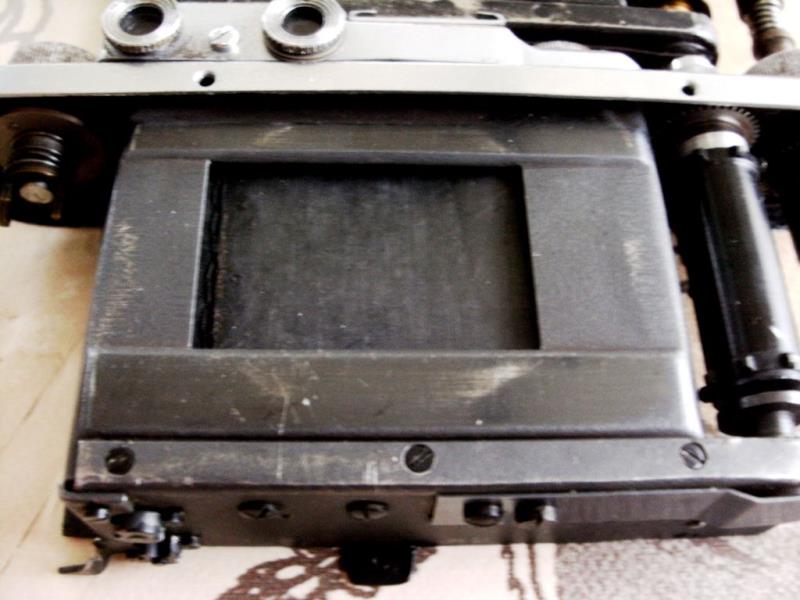
http://www.ussrphoto.com/UserContent/25112014_DSCF1704.JPG

http://www.ussrphoto.com/UserContent/25112014_
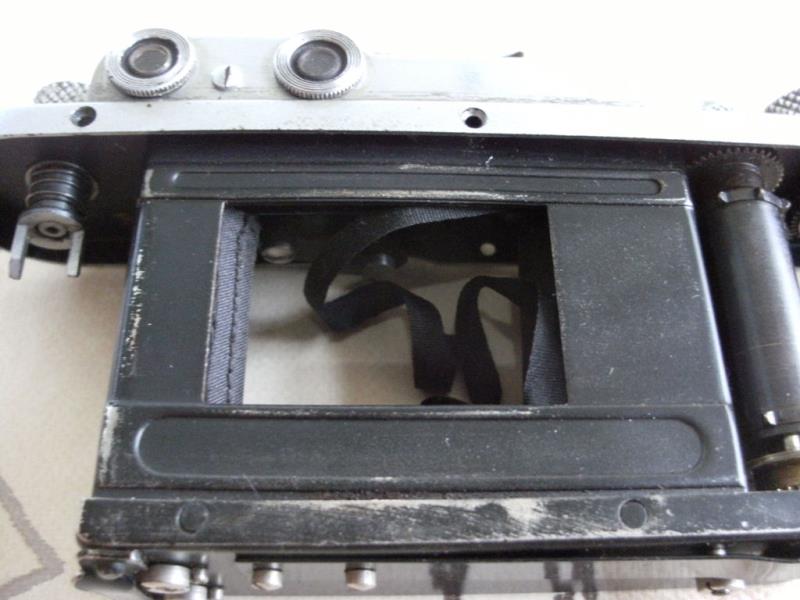
http://www.ussrphoto.com/UserContent/25112014_DSCF1706.JPG
No "rib" to reinforce the cage on the Leica fake. And screws always different.
|
| Jacques M. |
Posted - Nov 25 2014 : 04:33:55 AM
Detail concerning the screws to regulate the shutters and the lock of the baseplate.
Note that the Leica used two slot screws for their shutters until 1931, then 4 slots in 1932 (appearance of the Leica II), then 6 slots (Leica III). Fed kept the 2 slot one, except on the only Fed b (or V) I have seen (4 slots).
The lock of the baseplate is original.
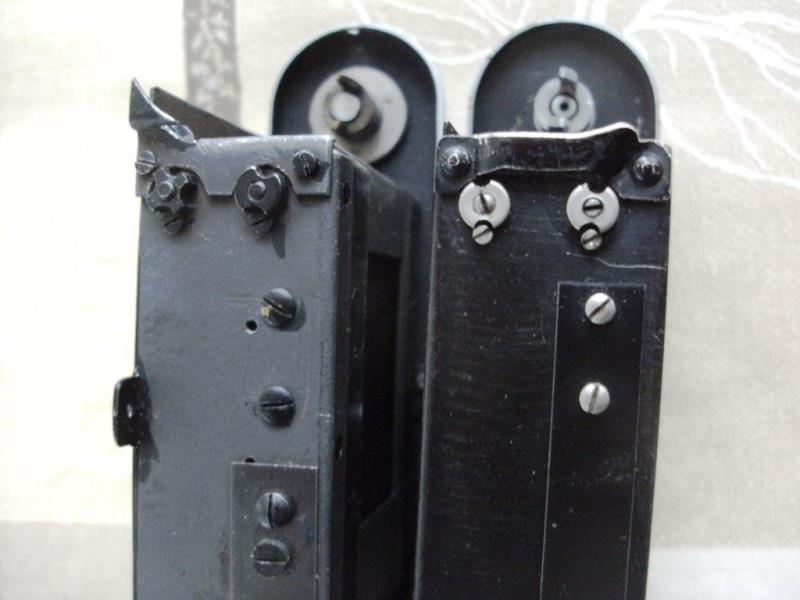
http://www.ussrphoto.com/UserContent/25112014_DSCF1701.JPG
|
| Jacques M. |
Posted - Nov 25 2014 : 04:25:41 AM
First comparison: the back part of the shutter box.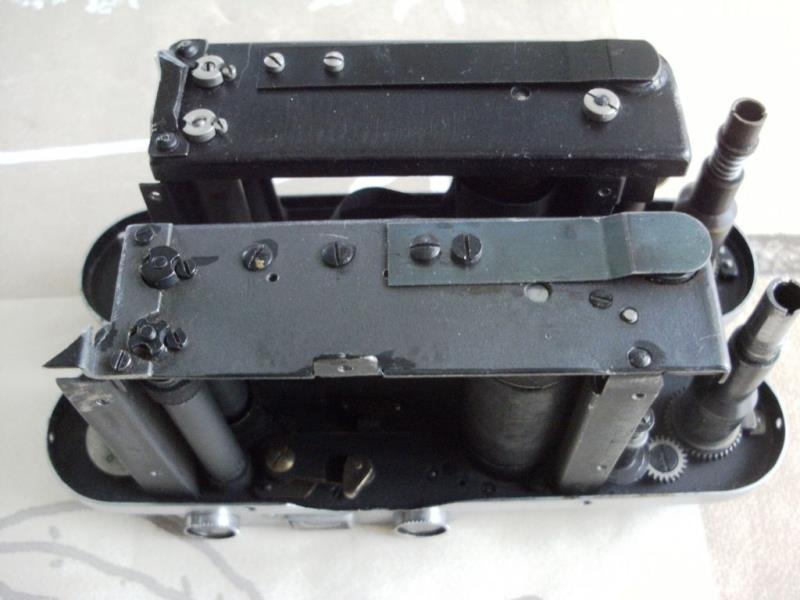
http://www.ussrphoto.com/UserContent/25112014_DSCF1699.JPG
The Leica fake is on the foreground, Fed 1d on the background.
Same general organisation, but all is slightly different: the screws, the release spring... |
| Jacques M. |
Posted - Nov 25 2014 : 04:12:48 AM
Yes, Juhani. When a lens without body meets a body without lens, it can make a camera... We have the date of the lens, not of the body...
Lenny: I have looked for internal détails on the net. I had seen the Pioneer on Fotoua. But they don't look like.
Jacques. |
| Lenny |
Posted - Nov 24 2014 : 12:16:09 PM
quote:
Originally posted by Jacques M.
almost all the internal details are different: position and size of screws, shape of the shutter box, springs and position of the film plate...
the release lever doesn't work like on Feds or Leicas.
The Pioneer on fotoua.com has a picture without the bottom-plate.
There might not be many other inside pictures of other early Leica copies.
|
| Jacques M. |
Posted - Nov 24 2014 : 11:56:55 AM
I have now partially dismounted this mysterious camera and a second one (a Fed 1d) to compare.
Of course, the technical solutions are globally the same: they both are Leica II copies. But almost all the internal details are different: position and size of screws, shape of the shutter box, springs and position of the film plate...
Feds are Leica copies; this one is not exactly that. It's a sort of transposition. For example, the release lever doesn't work like on Feds or Leicas.
Photos tomorrow: the battery of my numerics is OK now, but it's night here...
Jacques. |
| cedricfan |
Posted - Nov 24 2014 : 11:18:06 AM
This is what I also thought at first. But...
Maybe a loose lens with no camera to have it on? And no camera telling about the age of the lens?
Lens made of junk parts? Even I have some old FED lenses that are good for parts only.
Faked when, maybe an old production that was put on this camera to make it complete?
And maybe this obvious lens fake made the seller to believe also camera is a fake?
Best regards,
Juhani |
| Lenny |
Posted - Nov 24 2014 : 10:48:33 AM
quote:
Originally posted by Jacques M.
The lens must be a Fed with the diaphragm at the rear (middle on Elmars) and its number: 15035 (probably 1935).
the main buttons, the inscriptions on the counter and the speed dial, the rear of the shutter box when the baseplate is removed, the setting of the baseplate and the position of the screws which fasten the shutter box on the front. All that is neither Fed's nor Leica's.
That's interesting, no Fed cam and no Leica cam.
Would someone fake a Fed lens from 1935 into an Elmar nowadays?
|
| Jacques M. |
Posted - Nov 24 2014 : 09:00:14 AM
I have just received the camera.
Some words to share my first impressions.
It seems homogeneous: all is well adjusted and would work if the shutters were cleaned.
The chrome looks like the first Leica III(F) one of 1933: bright and somewhat peeling.
No hole to adjust the lens on the back, no hole on the press film inside.
The tip of the rangefinder could be a Fed 1c's with its drop shape.
The lens must be a Fed with the diaphragm at the rear (middle on Elmars) and its number: 15035 (probably 1935).
But there are things which are very strange: the main buttons, the inscriptions on the counter and the speed dial, the rear of the shutter box when the baseplate is removed, the setting of the baseplate and the position of the screws which fasten the shutter box on the front. All that is neither Fed's nor Leica's. And that could hardly have been home made.
Photos as soon as I can!
Amitiés. Jacques.
|
| Vlad |
Posted - Nov 20 2014 : 7:10:26 PM
Most of the AFA aerial cameras were developed by Geodezia: http://www.photohistory.ru/index.php?pid=1207248179952431
|
| Vlad |
Posted - Nov 20 2014 : 7:02:19 PM
FAG was made by factory Geodezia which also made aerial cameras. In 1941 it was evacuated from St. Petersburg, already under different name, to Ural mountain region to city of Sverdlovsk. It was making production for the war after the move. In 1949 it was repurposed from optico-mechanical factory into a radio-radar factory. Currently it exists under name of "Vektor".
Here's the site and some history if anyone is interested in running Google translate if you don't read Russian. http://www.vektor.ru/o_predpriyatii/istoriya
Cheers,
Vlad. |
| Lenny |
Posted - Nov 20 2014 : 4:15:32 PM
quote:
Originally posted by Jacques M.
You are right: the engraving on the frame counter and the speed dial are important too. The pins on the frame counter are between 10-15 and 30-35. Like the Fag! It's different on Leica/Zorki and Feds.
What happened to the FAG factory. If I remember correctly they were in competition with FED and lost. What did FAG produce later? |
| Luiz Paracampo |
Posted - Nov 20 2014 : 4:02:42 PM
Lots of questions!
But the câmera was not a Foca the shape was a leica and had its screw threaded lenses.
Regards
LP |
| Lenny |
Posted - Nov 20 2014 : 4:00:57 PM
So I just took some measurements from my screen. I know that this is not very accurate,
but I can say that
1. this body is same wide as a Leica-II and
2. the top here is not as wide as on a Leica-II,
this explains why a wider rewind button is possible.
I'm not an Leica expert, I don't know if there were different tops, but I would guess Leica had only one size for their rangefinder housing. |
| Jacques M. |
Posted - Nov 20 2014 : 3:48:09 PM
Thanks for your photos, Luiz.
The camera which was desintegrating itself, as you say, could have been a Foca 2 stars. The first series were made in Zamac...
But this one is visibly made of chrome plated brass. Not very good: it remembers me the first trials of chromed Leica II, and the wartime IIIf...
You are right: the engraving on the frame counter and the speed dial are important too. The pins on the frame counter are between 10-15 and 30-35. Like the Fag! It's different on Leica/Zorki and Feds.
Amitiés. Jacques. |
| Luiz Paracampo |
Posted - Nov 20 2014 : 3:19:21 PM
Similar screw on rangefinder (Leitz Museum)
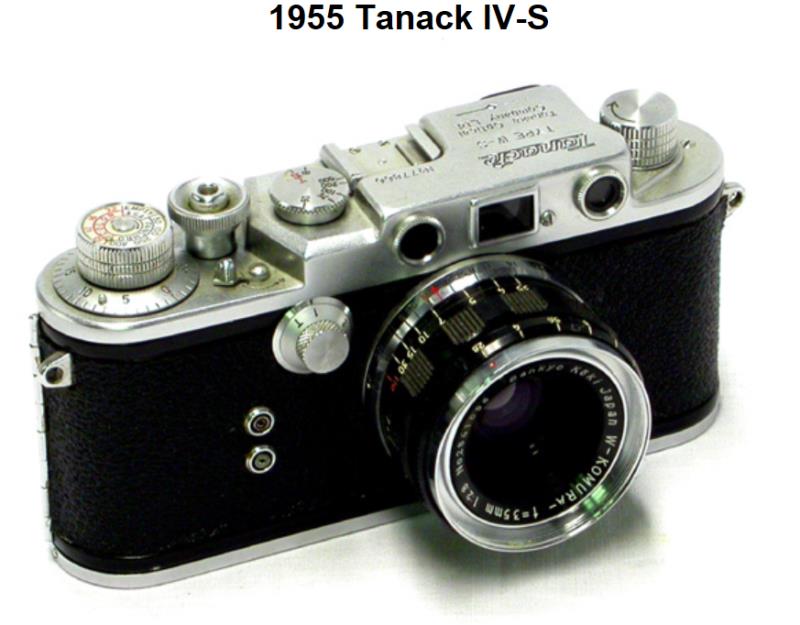
http://www.ussrphoto.com/UserContent/20112014_tanack IV-S.png
|
| Luiz Paracampo |
Posted - Nov 20 2014 : 3:02:24 PM
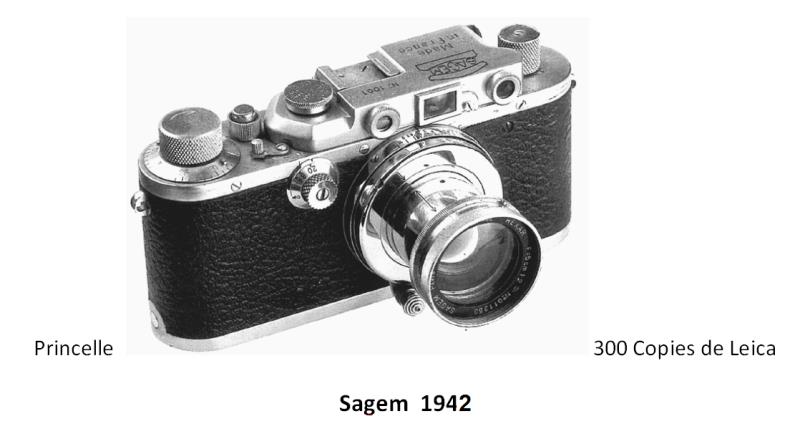
http://www.ussrphoto.com/UserContent/20112014_Sagem2.png
|
| Luiz Paracampo |
Posted - Nov 20 2014 : 2:46:59 PM
Some time ago there was sold a fake sagem from a Zorki câmera.
but this could be a pre-run Sagem.
Around the years 1960 When at University a friend of mine brought a strange "Leica" that was bought by his father in the War days.
This Fake "Leica" was in the worst possible condition and was desintegrating itself.
It seemed to me was made in Zamak and its leather was getting in powder.
I do not know where this câmera was from. there were much speculations.
Engravings on frame counter and speed dial Should be a way to get
its origins
|
| Jacques M. |
Posted - Nov 20 2014 : 11:23:27 AM
Yes, Lenny, I had a look at fotoua.com and on the site of Alexey Nikitin too (What marvels!).
Of course, there are similarities with Fag and VOOMP. But there are too similarities with any of the 35mm rangefinder Leica like cameras of this time. Normal: when a technical solution is chosen, generally, there are not many ways...
In fact, it would be necessary to have convergences at least on two details:
- the position of the screws on the front of the camera, which specifies the type of shutter box Inside (the heart of the camera!)
- the two main buttons I had never seen.
The cover is very interesting too. But it could be a special work for a camera previously without rangefinder: many Leica I were converted into II in 1932...
Factory or home made? It's the question...
Merci! Jacques.
|
| Lenny |
Posted - Nov 20 2014 : 10:18:06 AM
Just checked the FAG on fotoua.com, there are some similarities and only 50 pieces were produced. Who says those 50 were all the same. |
| Lenny |
Posted - Nov 20 2014 : 09:52:24 AM
quote:
Originally posted by Guido
the book "300 Leica copies" from Patrice-Herve Pont and Jean-Loup Princelle
By the way yesterday I took a look at all the cameras in this book and could not find a camera with such a frame around the viewfinder. Strange camera ...
Yes, very strange. But it can't be in the book if it's a real Leica. Imagine Leicashop couldn't recognize that it's a Leica and sold it to Jacques for let's say 250 euro and Jacques will sell it later for 50 thousand euro. Maybe Jacques is already getting offers. How is the asking price at this moment Jacques? |
| Jacques M. |
Posted - Nov 20 2014 : 07:36:52 AM
"300 Leica copies"... Just the book I don't have.
Thanks, Guido, for your researches.
When I have the camera, I will dismount the body. Sure we will know more after.
But if you have any ideas, don't hesitate!
As for the lens, it could be an early Fed by the fine knurling of the crown. But the outer front brass ring (to maintain the lenses) seems thicker than a Fed's.
I love these cameras which put questions!
Amitiés. Jacques. |
| Guido |
Posted - Nov 20 2014 : 06:49:29 AM
Hello Jacques
Even McKeown's don't know nothing about this camera called Sagem, but I found some pictures of of it in the book "300 Leica copies" from Patrice-Herve Pont and Jean-Loup Princelle (FotoSaga, 1990). As I can see your camera is not a Sagem.
By the way yesterday I took a look at all the cameras in this book and could not find a camera with such a frame around the viewfinder. Strange camera ...
Best wishes - Guido
|
| Jacques M. |
Posted - Nov 20 2014 : 06:02:34 AM
Sorry Juhani. It must be enthusiasm!
Luiz says:
"Fantastic! Of course! The viewer is very different from the Leica's. It can be a reminiscence of the rarissime Sagem, a French camera made in 1942. Perhaps a pre-pre production model. Only speculations..."
As for me, I already saw Sagem's images. Genuine ones, not Russian copies! But I am unable to find them again on the net. If you have that...
Amitiés. Jacques. |
| cedricfan |
Posted - Nov 19 2014 : 10:47:26 PM
What about posting in ENGLISH PLEASE!
Best regards,
Juhani |
| Luiz Paracampo |
Posted - Nov 19 2014 : 6:05:06 PM
Fantastique Jacques!
Bien sur! Les oculaires sont decisivement fort diferentes de la Leica!
Ils peutent d'etre réminiscences de la RARISSIME SAGEM!
de construction Française de 1942!
pre-pre-production model
Only speculations....
Regards
LP |
| Jacques M. |
Posted - Nov 19 2014 : 10:03:27 AM
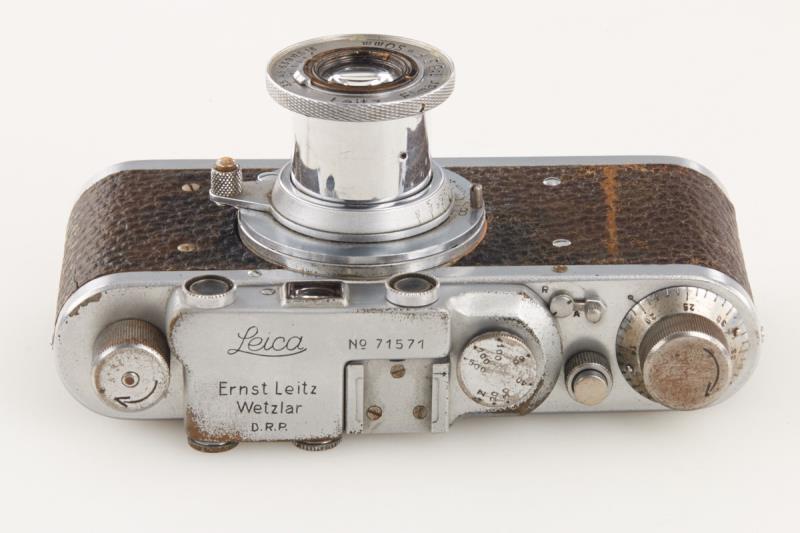
http://www.ussrphoto.com/UserContent/19112014_leica fake 4.jpg
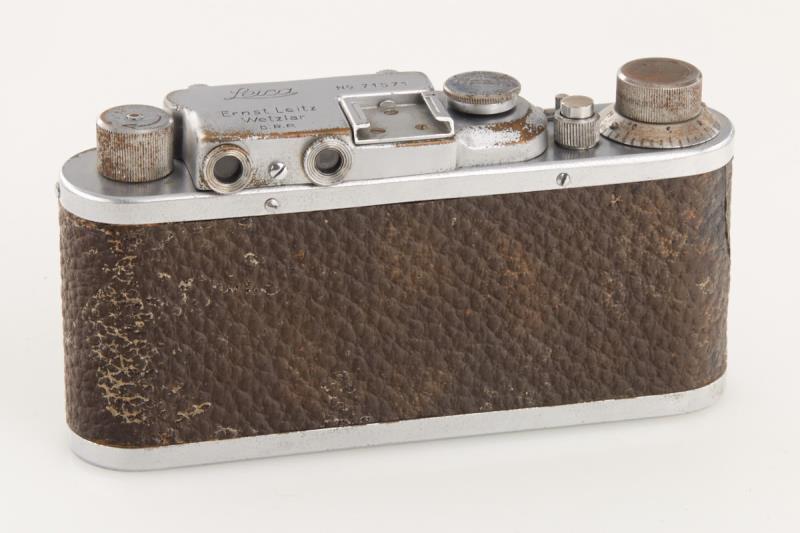
http://www.ussrphoto.com/UserContent/19112014_leica fake 3.jpg
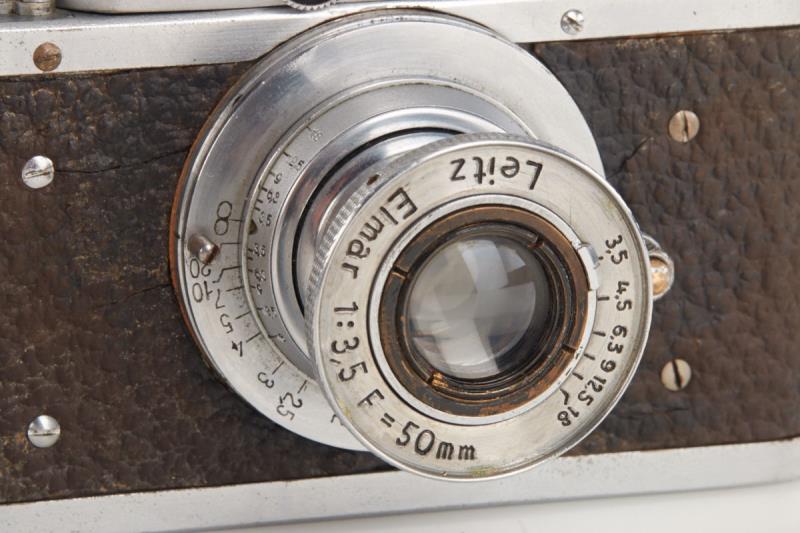
http://www.ussrphoto.com/UserContent/19112014_leica fake 2.jpg
Thanks for your answers, Luiz! Now, you have all the images.
I will have the camera next week, I think.
Several things surprise me:
- the rewind button is thick, as on a Leica 1 (A). So, a camera which would have been without rangefinder in a previous life?
- in that case, the cover will be less wide than a Fed's or a Leica 2's (which have narrow rewind buttons). I will check when I have it. And I will take all the measurements.
- the cover itself seems less high than a Fed's.
- the screws on the corners belong to Leica 1 (A) too.
- the 2 upper screws which maintain the shutter box are lower than on Feds or Leicas. So, the shutter box would be different from a Fed's.
Frankly, I had not thought of the Japanese track... I am going to study your link, Luiz. As for the Leicas IIf and IIIf, they are indeed a bit larger, but they have another metallurgy (and the cover is not detachable). The seller thinks it is a FSU production.
And of course, I will open it as soon as I have it, Lenny. Sure, it will answer some questions.
I go on seeking!
Amitiés. Jacques.
|
| Lenny |
Posted - Nov 19 2014 : 08:50:38 AM
quote:
Originally posted by Jacques M.
Most of the fakes are made from Feds or Zorkis. I am not sure it is the case here...
The screws on the upper plate and on the front of the belt , the metallurgy of the cover, specially about the viewer, the shape and the vertical stripes of the buttons, all is different.
But what if not a Fed? The condition of the chrome means the camera is probably prewar (and that the chrome was not good!). Note that the serial number is at the beginning of the Leica II Couplex series (s/n 71200).
A mix of several parts? But coming from where? A trial? This camera remembers something to me, but what?
Very interesting. I remember I saw screws on the sides before but forgot where. Jacques, how could you find this camera, please post a photo without the bottom-plate when you have it.
It doesn't make much sense to fake a Leica from a camera other than Feds or Zorkis. Those other cameras might be worth even more, like Reids and Kardons. |
| Luiz Paracampo |
Posted - Nov 19 2014 : 08:22:38 AM
a similar system is found in Leica IIf second series
LP
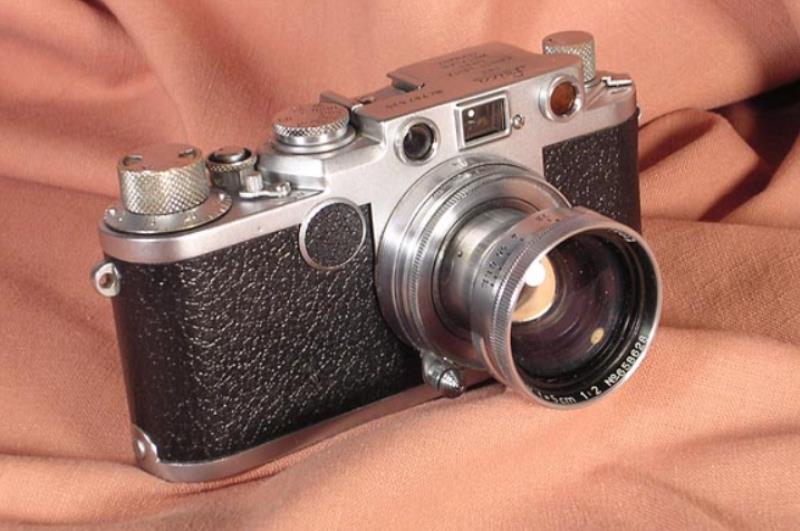
http://www.ussrphoto.com/UserContent/19112014_leica IIf.png
|
| Luiz Paracampo |
Posted - Nov 19 2014 : 08:05:27 AM
See this interesting Neuca Prototype
http://collectiblend.com/Cameras/Neubert-Franz/Neuca-Prototype-(black).html
LP |
| Luiz Paracampo |
Posted - Nov 19 2014 : 08:04:35 AM
Hello Jacques!
It seems to be a japanese prewar câmera.
At same time due the rewind buttom the câmera seems to have a somewhat larger length . Please confirm.
The image finder constructiun apperas to be from the first Leotax Items perhaps.
I will study the image.
Can You send more ones?
Best Regards
LP |
